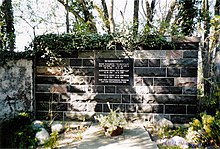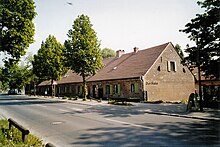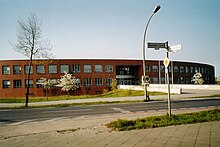Berlin-Falkenberg
|
Falkenberg district of Berlin |
|
|---|---|
| Coordinates | 52 ° 34 '10 " N , 13 ° 32' 19" E |
| surface | 3.06 km² |
| Residents | 1870 (Dec. 31, 2019) |
| Population density | 611 inhabitants / km² |
| Incorporation | Oct. 1, 1920 |
| Post Code | 13057 |
| District number | 1104 |
| Administrative district | Lichtenberg |
Falkenberg is a district in the Lichtenberg district of Berlin . The village is located on the north-eastern outskirts of the city, surrounded by wide fields - the former sewage fields of the city.
The Falkenberg and the Garden City Falkenberg , both in Bohnsdorf in the Treptow-Köpenick district , near the Grünau S-Bahn station, have the same name within Berlin .
history
From the foundation to the 19th century

The street village was created in the 13th century by peasant settlers on the Barnim . The first written mention followed on June 26, 1370 in a document of Margrave Otto the Lazy . No pictorial representations have survived from the coat of arms of the rural community of Falkenberg. According to descriptions, it was designed according to the seal of the community and shows a grain sheaf with flails, scythe and rake crossed upright. This coat of arms is not of medieval origin.
In 1791, Falkenberg was acquired by Marie-Elisabeth von Humboldt - the mother of Wilhelm and Alexander von Humboldt . She bought the estate from a lieutenant colonel von Lochau. In 1795, Frau von Humboldt had the old village church redesigned in the style of classicism by the Berlin builder Paul Ludwig Simon and provided with a stone tower in Egyptian shapes. After her death in 1796, at the age of 55, she found her last rest in her - together with her husband Alexander Georg von Humboldt and her first husband Friedrich Ernst von Holwede (1723–1765) and a daughter from her first marriage who died early. The Falkenberg estate was inherited by Ferdinand von Holwede, the son from his first marriage. He sold it in 1804 to a member of the von Alvensleben family . In 1875 the city of Berlin acquired the former manor for the establishment of Rieselfeldern .
Falkenberg in the 20th century

The incorporation followed in 1920 by the Greater Berlin Act ; Falkenberg was now part of the newly created district of Weißensee .
In the 1930s and 1940s there were only minor expansions in the area of the old village, only a few settlements in the direction of Ahrensfelde and the Catholic Church of St. Konrad von Parzham were built. On April 21, 1945, a few days before the Red Army marched in , members of the Wehrmacht blew up the 700-year-old village church. Unlike in the surrounding villages, the demolition did not only affect the tower, which was often used as an orientation. The family crypt of Marie Elisabeth von Humboldt in the old churchyard - near the manor park - was bricked up in 1969 next to the remains of the destroyed stone church and provided with a memorial wall. The preserved coffin panels of the crypt and the church flag from 1795 are housed in the new building of the Protestant church in Wartenberg, built in 2000, in today's Neu-Hohenschönhausen district.
When the construction of large housing estates began in East Berlin , Falkenberg was hardly affected. The district was outside the interest of urban development. In this context, a small area has been awarded the 1979 station Ahrensfelde to Berlin-Marzahn incorporated. On September 1, 1985, Falkenberg was separated from the Weissensee district together with the districts of Hohenschönhausen , Malchow and Wartenberg and merged into the new Hohenschönhausen district.
In the course of urban development, the sewage fields here and in the surrounding area were replaced by a modern sewage treatment plant in 1968 . The Falkenberg sewage treatment plant in what is now the Marzahn-Hellersdorf district served not only its main function as a water purification plant, but also as a water dispenser for the small river Wuhle .
The district from 1990 and in the 21st century

In 1998 the new school building of the Barnim-Gymnasium was opened. On January 1, 2001, Falkenberg came to the district of Lichtenberg through the district reform like the other districts of Hohenschönhausen . In the same year, the Berlin animal shelter opened a completely new building here. Due to its architecturally attractive construction, the facility is always of interest to film directors. The until then southern part of Falkenberg, which stretched at an acute angle to the Gehrenseestraße S-Bahn station, came to Neu-Hohenschönhausen in 2002. The new building district affected by this is still popularly referred to as the Falkenberg development area. Since then, the neighboring Falkenberger Krugwiesen no longer belong to the district that gives it its name. In the newly designed coat of arms of the Lichtenberg district (see below), the district is symbolized by one of the three golden ears of corn that stand for the three historic village centers of Malchow, Wartenberg and Falkenberg.
The sewage treatment plant was closed in 2003 and the wastewater from its catchment area is being treated by the more modern sewage treatment plants in Waßmannsdorf and Schönerlinde . Critics feared that the Wuhle could dry up as a result, which did not happen until 2012.
Since 2016, a new district with 1200 new apartments has been built between Gehrensee and Ahrensfelder Chaussee by the municipal housing associations Howoge , Gewobag and Gesobau . Therefore the population of the district will more than double within a few years.
population
| year | Residents |
|---|---|
| 2007 | 1152 |
| 2010 | 1215 |
| 2015 | 1597 |
| 2016 | 1604 |
| 2017 | 1557 |
| 2018 | 1541 |
| 2019 | 1870 |
Source: Statistical Report AI 5. Population in the State of Berlin on December 31st. Basic data. Office for Statistics Berlin-Brandenburg (respective years)
traffic
The main thoroughfare in Falkenberg is Dorfstraße and Ahrensfelder Chaussee as its eastern extension. The Dorfstraße, in turn, is the eastern extension of the Falkenberger Chaussee coming from the new development areas of Neu-Hohenschönhausen and has always been the connection to Berlin. To the east it turns into the Ahrensfelder Chaussee, the south side of which forms the border to Marzahn and which finally leads on towards Bad Freienwalde (Oder) .
In local public transport , Falkenberg is served by the terminal stop of the same name on the M4 and M17 tram lines on the western edge of the village. In addition, the bus route 197 from Prerower Platz to Mahlsdorf S-Bahn station crosses the district in an east-west direction.
Architectural monuments and sights
All architectural monuments are located along the village street.
- Number 39: Cemetery from the 14th century with a cemetery chapel built around 1895 and the remains of the medieval village church including the Humboldt Crypt.
- Numbers 1, 4 13, 31–34, 44, 46 and 51: numerous residential buildings, stables and barns from the second half of the 19th century
The former farm workers' house
In 1856, Graf von Arnim had three of the simplest buildings demolished and the manor workers' house built as a single-storey building with two gabled rooms. The outer walls are made of hard-burned red bricks and unfired adobe bricks . Eight families lived in the house downstairs, but there was only one kitchen for each four. Unmarried workers from the estate were housed in the two lofts that had been expanded. Certainly the sanitary facilities of the house were improved in the 20th century, so that the building was inhabited by three families until 1972. In 1978 it was listed as a monument , but was only used as a storage building. After the reunification , in 1997, a newly founded association for the development of the Northeast Landscape Park bought the Lehmkate. With funds raised by the Friends' Association, with financial support from the responsible district office, with voluntary helpers and under the direction of Baufachfrau Berlin e. V. a comprehensive renovation took place. In 2003, the Friends' Association received the medal named after the art historian Ferdinand von Quast from the Senate Building Department for its special monument preservation services . The house was reopened on October 11, 2002. It now serves as the headquarters for the Friends' Association and as an information center for Barnimer Feldmark . In 2003, Canadian Lynn Densmore opened the Café Lehmsofa here .
The sights also include
- Ahrensfelder Chaussee 79/81: Catholic Church Sankt Konrad von Parzham (cultural monument as a whole)
- Hausvaterweg 39: Berlin animal shelter
- Hausvaterweg 16: fire station
- Ahrensfelder Chaussee 41: Barnim high school
→ See also: List of cultural monuments in Berlin-Falkenberg
nature
In the north of the district on the border with the Brandenburg community of Ahrensfelde are the renatured Gehrensee and the Falkenberger Rieselfelder nature reserve .
Web links
- Outline of the history of Falkenberg on the website of the district office
- Images of nature and the history of Falkenberg
Individual evidence
- ↑ Broken . In: Berliner Zeitung , December 18, 2008, accessed on February 23, 2013
- ^ Museum Lichtenberg: memorial plaques for churches in Malchow and Falkenberg
- ↑ Press release of March 27, 2003: Falkenberg sewage treatment plant closes - wastewater flows into state-of-the-art systems
- ↑ “Mein Falkenberg”: New building project by the three municipal housing associations Gewobag, GESOBAU and HOWOGE. HOWOGE, accessed November 22, 2018 .
- ↑ Statistical report AI 5 - hj 2 / 19. Residents in the state of Berlin on December 31, 2019. Basic data. P. 26.
- ↑ BD Falkenberg cemetery chapel
- ↑ BD Dorfstrasse 1, residential complex (1850), barn, stable (1900) ,BD Dorfstrasse 4, farm workers' house (1856) ,BD Dorfstrasse 31–34, farm workers' house (1890) ,BD Dorfstrasse 13, house (1875), stable (1870), barn (1900) BD Dorfstrasse 44, house (1866), stable (1860) BD Dorfstrasse 46, (stable from 1860) BD Dorfstrasse 51, house and barn (1880)
- ^ Ina Ritzmann (Lower Monument Protection Authority): A former manor workers' house ; In: Lichtenberger Rathausnachrichten from January 16, 2010
- ↑ Detailed history of the Falkenberg village house ( memento of the original from March 4, 2016 in the Internet Archive ) Info: The archive link has been inserted automatically and has not yet been checked. Please check the original and archive link according to the instructions and then remove this notice. , accessed December 4, 2015
- ↑ Falkenberg volunteer fire brigade website ( memento of the original from April 2, 2015 in the Internet Archive ) Info: The archive link has been inserted automatically and has not yet been checked. Please check the original and archive link according to the instructions and then remove this notice.
- ^ Homepage Falkenberg High School
- ↑ Umweltzeitung on www.sozdia.de







